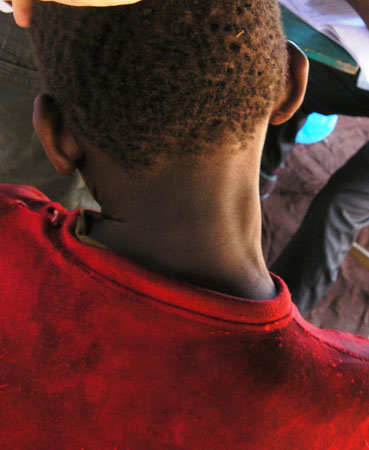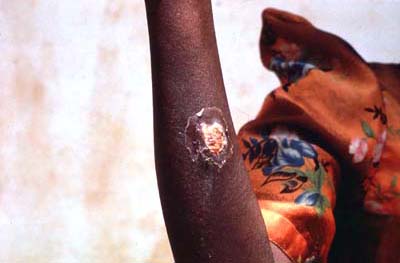History and exam
Key diagnostic factors
common
presence of risk factors
Strong risk factors are exposure to tsetse fly, living in an area with people infected with gambiense human African trypanosomiasis (HAT), and living in an area with animals infected with rhodesiense trypanosomiasis.[25]
previous stay in rural west and central Africa (Trypanosoma brucei gambiense)
The geographical region determines the disease form. Owing to the chronicity and relatively mild symptoms in first-stage disease, patients with gambiense HAT may present months to years after exposure to the infective bite.
previous stay in game parks in east and southern Africa (T b rhodesiense)
The geographical region determines the disease form.
enlarged cervical lymph nodes/Winterbottom's sign (T b gambiense)
Sometimes easily visible (Winterbottom's sign), sometimes neck palpation is necessary to detect. Lymph nodes feel rubbery, and are discrete, mobile, and painless without suppuration. Typical in gambiense HAT. [Figure caption and citation for the preceding image starts]: Enlarged cervical lymph nodes (Winterbottom's sign) is a characteristic sign for infection with T b gambienseFrom the collection of Dr J.R. Franco [Citation ends].
chancre (T b rhodesiense)
A 3- to 4-cm inflammatory lesion appearing after 2-3 days at site of infective bite. Typical in rhodesiense HAT. [Figure caption and citation for the preceding image starts]: The inoculation chancre that develops at the site of the tsetse bite is a characteristic sign for infection with T b rhodesiensePublished with permission from WHO; TDR; de Raadt [Citation ends].
disturbances of consciousness and sleep
Slowing down of mental functions with diminution of attention, total indifference, and apathy are observed.
Daytime somnolence and uncontrollable urges to sleep are characteristic signs of second-stage gambiense HAT. Polysomnographic recordings show an alteration of the sleep-wake cycle with short sleep episodes that occur equally during day and night and an alteration in structure of sleep episodes with frequent sleep-onset REM sleep periods.[57]
Other diagnostic factors
common
history of several treatments against malaria with no improvement
HAT is often misdiagnosed as malaria.
headache
Typically severe and persistent.
fever
May be irregular, lasting 1-3 days. Febrile episodes are more pronounced in rhodesiense HAT than in gambiense HAT.
fatigue and general malaise
Also observed in many other conditions.
history of infertility, menstrual disorders, high miscarriage rate (women)
Endocrine dysfunctions are common.
reduced libido, impotence (men)
Endocrine dysfunctions are common.
pruritus
Often not reported by the patient unless questioned.
oedema
Swelling of lower eyelids in gambiense HAT.
Swelling of legs and arms in rhodesiense HAT.
impaired motor functions
Hypertonicity or hypotonicity.
Abnormal movements include trembling of hands and fingers and choreiform, athetoid, or oscillatory movements of the arms, head, neck, or trunk.
Real paralysis occurs in very rare cases.
Perioral and cheiro-oral (sensory disturbance around the corner of the mouth and the palm of the hand on the same side) reflexes of the cerebral trunk are almost a constant.
mental changes
Emotional lability, indifference, aggression, antisocial behaviour, stereotypic behaviour, impulsive actions, fugue states, manic episodes, melancholia, delirium, and/or dementia.
uncommon
rash
Rash (ring-like patches) only seen in people with lighter skin, rarely in people with darker skin.[58]
hepatosplenomegaly
May be seen in both gambiense HAT and rhodesiense HAT.
sensory disorders
Hyperaesthesia (Kerandel's sign); general hypersensitivity to stimuli; paraesthesia; a variety of cramps, muscle, or bone pains may be seen.
Risk factors
strong
exposure to tsetse fly
The risk is directly related to close contact with the tsetse fly. This contact usually occurs in rural settings, populations of low socioeconomic status, and known foci of human African trypanosomiasis (HAT).[25]
The contact is related to activities that are usually carried out in the habitat of the fly: fishing in rivers or mangrove areas; fetching water and washing; hunting; honey collection; brewing of local beverages; preparing cassava; wildlife watching, and control of game and wildlife areas; cattle herding; and firewood collection.
The social upheaval related to wars, migrations, and other movements of the population could be a factor that increases the vector contact.
living or working in an area with people infected with gambiense trypanosomiasis
Apart from the presence of vectors, the presence of parasites in reservoirs is needed. The main reservoir in gambiense HAT is infected human beings. Control activities are based on active case finding and treatment of detected cases, reducing the reservoir and therefore the transmission of the disease.
The role played by animals (including domestic animals) in maintaining the endemicity is not well known.
living or working in an area with animals infected with rhodesiense trypanosomiasis
Apart from the presence of vectors, the presence of parasites in reservoirs is needed. In the case of rhodesiense HAT, the disease is considered as a zoonotic disease and animals are the main hosts with occasional transmission to humans. Two epidemiological situations have been described: one where the main reservoir is cattle and transmission occurs to the population dealing with livestock; and another situation where the main reservoirs are wild animals and transmission is related to hunting or wildlife watching and conservation activities.
Use of this content is subject to our disclaimer